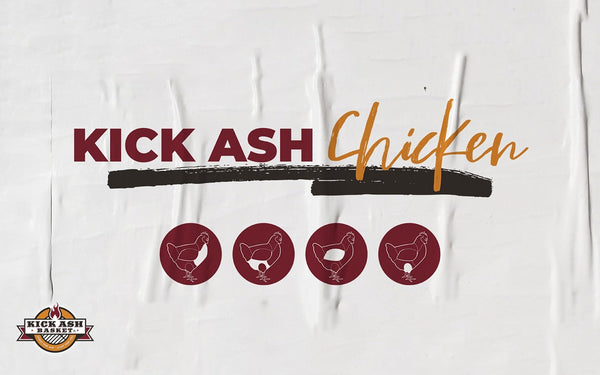
Kick Ash Chicken
Temperature Over Time
One of the first things you learn as you attempt to up your grill game is to cook to temperature and not time. Steak should be cooked to 120 degrees and then seared, whereas brisket and pork shoulder should be cooked to 205 degrees and chicken should be cooked to 165 degrees.
The classic misunderstanding of time over temperature can lead to some embarrassing situations when cooking for a group. Your wife asks you when dinner will be ready and you respond with 10 more degrees. With steak and now pork, you can safely pull meat early and not risk your health, but never chicken. It must always be cooked to 165 degrees... or does it?
Breasts, thighs, wings and legs
The first thing we need to discuss is the different parts of a chicken. We will stick to the most common parts: breasts, thighs, wings, and legs. KFC taught us that wings were white meat, but they tend to cook more like dark meat.
The major difference between white and dark meat is how the muscle is used by the bird. The breast and wings are not active muscles, so those cuts tend to be leaner and more tender from the start. Dark meats are the active muscles that carry weight such as legs and thighs. They tend to be denser and higher in fat and tendons. This changes how you need to cook them. I treat wings more as dark meat because of the amount of bones and tendons in the meat as you will not usually find boneless wings.
It seems that, when dealing with white meat, grill masters have had it beaten into their brains that you must cook to 165 degrees to prevent making your guest sick. Also, that any shade of pink in cooked chicken will make you sick.
Both of these beliefs are no longer universal if you understand the science behind them. As with most food safety, the FDA tried to make it simple so that everyone was safe. What this led to was overcooked, dried out chicken breasts and under cooked chicken thighs, wings, and drums.

Photo by Daniel Hooper on Unsplash
White Chicks
Starting with white meat, let’s explore where the 165 degree number comes from. The FDA determined that at 165 degrees the bacteria that can make you feel sick will be killed almost immediately. What is usually left out is that you can still kill the bacteria at lower temperatures. It just takes time and not a lot of it. As you can see below, you can kill bacteria at 150 degrees in as little as 3 minutes!
| Temperature | Time to achieve bacterial death (in lean white meat) |
|---|---|
| 150°F (65.6°C) | 3 minutes |
| 154°F (67.8°C) | 1 minute |
| 155°F (68.3°C) | 49.5 seconds |
| 156°F (68.9°C) | 39.2 seconds |
| 157°F (69.4°C) | 31 seconds |
| 160°F (71.1°C) | 15.3 seconds |
| 161°F (71.7°C) | 12.1 seconds |
| 162°F (72.2°C) | 9.6 seconds |
Now that you are more confident that you are not going to make anyone sick, what’s next?
First, get yourself an instant read thermometer you can trust. I started with a ThermaPop and then upgraded to a ThermaPen. They aren’t the cheapest ones on the market, but they are accurate, easy to use, and well made. There are literally hundreds on the market, so find one in your budget that you are comfortable with.
Next, prepare your grill. If you have a Kick Ash Basket that should mean loading up your favorite charcoal into your KAB, but we won’t judge you much if you are still using gas. For boneless/skinless breasts, I usually cook around 350 to 400 degrees and flip every 5 to 7 minutes until the meat reaches an internal temperature of 155 degrees for about a minute. The meat will continue to cook once you remove from the grill so this is plenty safe. You should also use a Kick Ash divider if you want to ensure you don’t burn the outside while bringing up the internal temperature.
Remember, smaller pieces will cook faster; so, to avoid overcooking the smaller pieces, you will need to pull them sooner. Another method is to start your larger pieces first and then add the smaller pieces after the first flip to try and finish everything at the same time. I don’t usually flip bone-in breasts and just cook it bone side down.
Oh no, it’s still pink!
What if your chicken is still pink? What if the juices don’t “run clear”?
Although most people have a reasonably high tolerance for pinkness in many red meats, misconceptions about “bloody” or pink chicken can scare off even the most intrepid cooks and diners. In actuality, once you have confirmed the chicken is fully cooked with a reliable meat thermometer, you can rest assured that there are many other reasons the chicken could still be pink that have nothing to do with doneness.
Younger chickens, lower PH levels, and myoglobin (the purplish protein that delivers oxygen to chickens when they are moving) can all cause that tell-tale pinkness, but none of these things have adverse effects on health or taste if the chicken has been cooked to the right temperature for the right amount of time.
Come to the dark side
Now that we have covered white meat, let’s delve into dark meat. If you grew up in the 90’s and the low-fat craze of that decade, you may not have eaten much dark meat growing up. Or, it was cooked to 165 which made it tough and chewy.
This is why dark meat, especially on a bone, should be cooked to a higher temperature. The extra fat and tendons need time to break down and cooking to a higher temperature will simulate just that—more time. This is also why you see wings and legs cooked low and slow giving them even more time. You can raise the temp as you cook to crisp up the skin as desired. I’ve found that cooking above the recommended 175 degrees for wings has given me great results. The flats will almost fall apart in your mouth and remain tender and juicy. The drums meat will bite off cleanly without having to fight a rogue tendon.
My preferred method for bone-in dark meat is cooking indirect at 250-275 for about 2 hours. Then I’ll brush on sauce and raise the temp to 300 until they reach a finish temp of 180-185 degrees.
Bridge the gap from white to dark meat
One meat to play with if you are new to dark meat is boneless/skinless thighs. This can be the intro meat to draw breast eaters to the dark side. Their higher fat content allows for higher cooking temperature and additional flavor. However, they tend to be smaller pieces and cook relatively quickly. Because the bone is cut out, they also tend to have more surface area exposed to direct heat when cooking. The quick cooking time means you should stagger your start times if you are cooking with other cuts at the same time. Target finish temps should be in the 165-170 range when cooked at about 400 degrees, anticipating that they will continue to cook once pulled from the grill.
Get grillin’
Now that you have some ideas of what to do next, find or revisit your favorite recipes and reintroduce yourself to chicken. Remember, you’re now cooking to temperature and not time, which can be a little stressful. However, the improved quality of the final results will make it worth the wait or justify eating a little early at the very least.
This is a guest post by Bill Dehn
Bill is just a guy with a grill and the internet. Like most, he started with a gas grill and a cheap smoker. Eventually, he upgraded to a Big Green Egg. He was a house husband for a couple of years which gave him time to research how to improve his grill work. Now even when he thinks he screw up on the grill, his family is still pretty happy.

